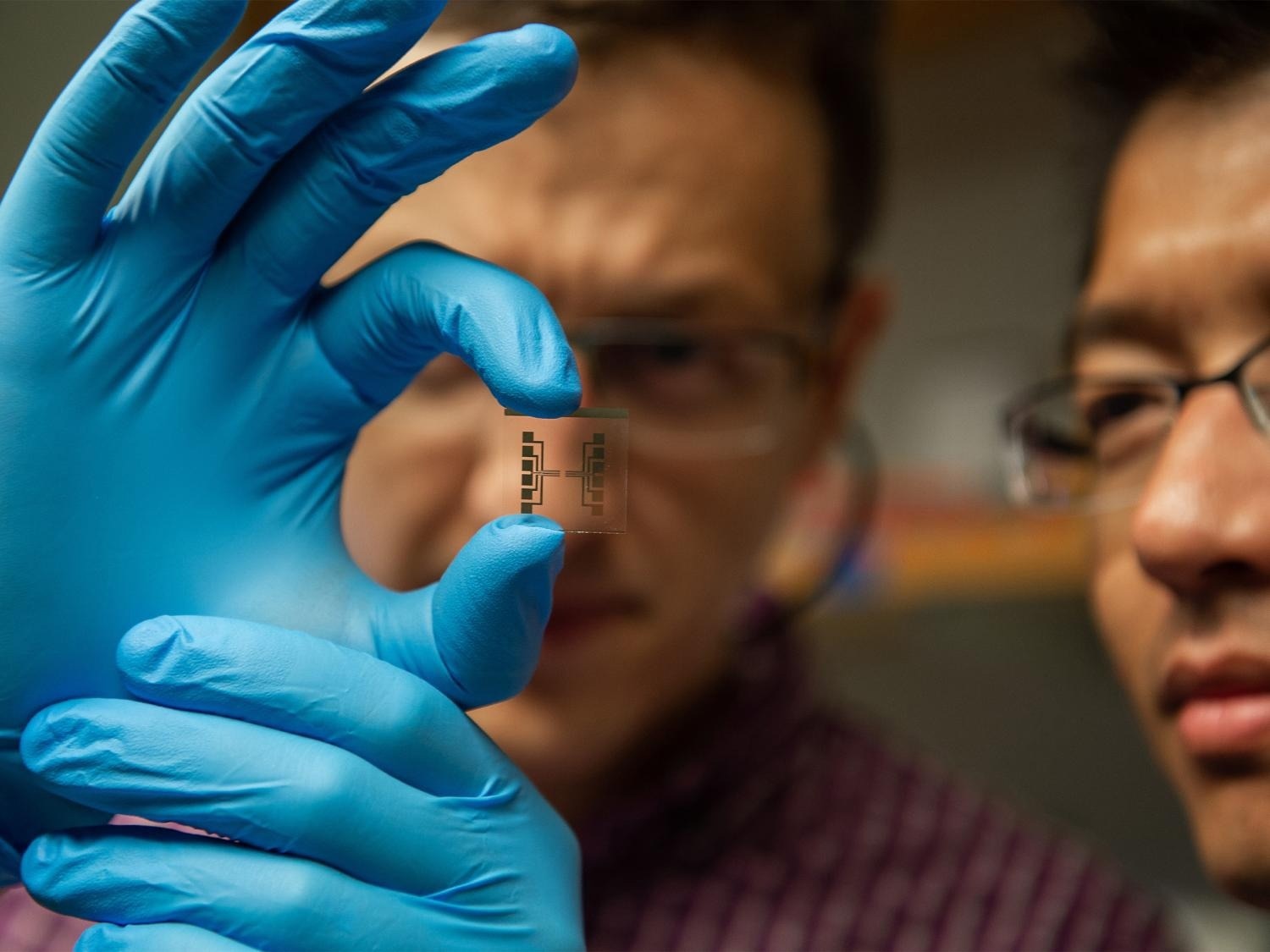Thanks to a Penn State collaboration, environmental sensors are one step closer to simultaneously detecting several chemicals that can signify disease or pollution.
 Penn State researchers used a new laser writing technique to develop the first highly customizable microscale gas sensing devices. Image Credit: Kelby Hochreither/Penn State.
Penn State researchers used a new laser writing technique to develop the first highly customizable microscale gas sensing devices. Image Credit: Kelby Hochreither/Penn State.
The first extremely adaptable microscale gas sensing devices were created by Huanyu “Larry” Cheng, associate professor of engineering science and mechanics in the College of Engineering, Lauren Zarzar, assistant professor of chemistry in the Eberly College of Science, and their colleagues by combining laser writing with responsive sensor technologies.
This month, researchers published their technique in the American Chemical Society journal Applied Materials & Interfaces.
The detection of gases is of critical importance to various fields, including pollution monitoring, public safety assurance, and personal health care. To fill these needs, sensing devices must be small, lightweight, inexpensive and easy to use, and apply to various environments and substrates, such as clothing or piping.
Huanyu “Larry” Cheng, Associate Professor, Department of Engineering Science and Mechanics, College of Engineering, The Pennsylvania State University
The problem, according to Cheng, is developing devices with the required qualities while also being able to be customized with the infrastructure required for precise and accurate sensing of several target gases at once. Zarzar’s knowledge of laser writing is useful in this situation.
Laser writing techniques give design freedom to a wide range of fields. Expanding our understanding of how to directly synthesize, pattern and integrate new materials—especially nanomaterials and nanomaterial composites—into complex systems will allow us to create increasingly more sophisticated and useful sensing technologies.
Lauren Zarzar, Assistant Professor, Department of Chemistry, Eberly College of Science, The Pennsylvania State University
The laser-induced thermal voxel technique, created by Zarzar’s research team, permits the simultaneous production and integration of metal oxides onto sensor devices. Metal oxides are substances that cause various molecules to react with them, activating the sensing process.
The researchers first dissolve metal salts in water before focusing the laser into the solution to create laser writing. Metal oxide nanoparticles that may be sintered onto the sensor platform are produced as a result of the solution’s breakdown at high temperatures.
The method simplifies earlier techniques, which called for a pre-defined mask of the planned pattern. Any modifications required the construction of a new mask, which was time- and money-consuming. According to Zarzar, laser writing is “maskless,” and when used in conjunction with the thermal voxel process, it enables quick testing of various designs or materials to identify the best combinations.
Precise patterning is also a necessary component for the creation of ‘electronic noses,’ or arrays of sensors that act like a nose and can precisely detect multiple gases at the same time.
Alexander Castonguay, Study Co-First Author, Graduate Student, Department of Chemistry, The Pennsylvania State University
Castonguay also added, “Such precise detection requires the patterning of different materials in close proximity, at the thinnest microscale. Few patterning techniques have the resolution to do this, but the approach detailed in this study does. We plan to use the techniques and materials described here to develop electronic nose prototypes.”
Five different metals and metal alloys that are currently utilized in sensors were evaluated by the researchers. Castonguay claims that a heterojunction, or the meeting of two distinct metal oxides, creates a special environment at the two materials’ interface that improves the responsiveness of gas sensors.
The researchers discovered that, compared to copper oxide alone, a heterojunction of copper oxide and zinc oxide exhibits a five to twenty-fold increased reactivity to the test gases (ethanol, acetone, nitrogen dioxide, ammonia, and hydrogen sulfide).
“This finding supports other reports in the scientific literature that the creation of mixed oxide systems can lead to significant increases in sensor response and demonstrates the efficacy of the laser-induced thermal voxel technique for mixed-oxide gas sensor fabrication,” Castonguay stated.
Castonguay explained, “We hope by pooling the laser writing knowledge of the Zarzar group with the wearable sensor expertise of the Cheng group, we will be able to expand our capabilities to create novel, customizable sensors.”
In addition to these Penn State institutions, Cheng also has links with the Materials Research Institute, the Institutes of Energy and the Environment, the Institute for Computational and Data Sciences, the College of Earth and Mineral Sciences, and a number of engineering departments.
Ning Yi, a co-first author from the Penn State Department of Materials Science and Engineering, Bowen Li, Jiang Zhao, Han Li, Yuyan Gao, and Naveen Tiwari from the Penn State Department of Engineering Science and Mechanics, as well as Nabila Nova from the Penn State Department of Chemistry, are the other authors. Han Li is also affiliated with the Xiamen University Pen-Tung Sah Institute of Micro-Nano Science and Technology.
This work was made possible by funding from the National Science Foundation, the Sloan Research Fellowship, the National Institutes of Health, the Penn State Institutes of Energy and the Environment, and the Penn State Leighton Riess Graduate Fellowship in Engineering.
Journal Reference:
Castonguay, A. C., et al. (2022) Direct Laser Writing of Microscale Metal Oxide Gas Sensors from Liquid Precursors. ACS Applied Materials & Interfaces. doi.org/10.1021/acsami.2c03561.